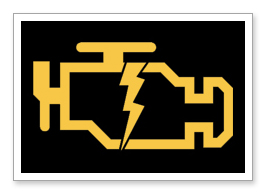Few things are as worrisome as having the CHECK ENGINE light go on while driving.
These tips from Consumer Reports can help you determine whether your vehicle has a loose gas cap or serious engine problems.

The feared check engine light!
Call it the most misunderstood indicator on your dashboard, the "check engine" light can mean many different things, from a loose gas cap to a seriously misfiring engine. Ignore the warning, and you could end up damaging expensive components. It also can be a sign that your car is getting poor fuel economy and emitting higher levels of pollutants.
What the Light Means The "check engine" light is part of your car's so-called onboard diagnostics (OBD) system. Since the 1980s, computers increasingly have controlled and monitored vehicle performance, regulating such variables as engine speed (RPM), fuel mixture, and ignition timing. In some cars, the computer also tells the automatic transmission when to shift. When it finds a problem in the electronic-control system that it can't correct, the computer turns on a yellow warning indicator that's labeled "check engine," "service engine soon" or "check powertrain."
Or the light may be nothing more than a picture of an engine, known as the International Check Engine Symbol, perhaps with the word "Check." In addition to turning on the light, the computer stores a "trouble code" in its memory that identifies the source of the problem, such as a malfunctioning sensor or a misfiring engine.
The code can be read with an electronic scan tool or a diagnostic computer, standard equipment in auto repair shops. There are also a number of relatively inexpensive code readers that are designed for do-it-yourselfers. Manufacturers originally used the OBD system to help technicians pinpoint and troubleshoot malfunctions. But the systems now are required under federal laws governing automotive emissions. Although larger trucks have been exempt from the requirement, that quickly is changing. "The ‘check engine' light is reserved only for powertrain problems that could have an impact on the emissions systems," says John Van Gilder, General Motors' lead OBD development engineer. Exactly what the OBD system looks for depends on the make, model and year. The original systems varied widely in their capabilities. Some did little more than check whether the various electronic sensors and actuators were hooked up and working.
That changed by 1996, when, under OBD II regulations, carmakers were required to install a much more sophisticated system that essentially acts like a built-in state emissions testing station. The computer monitors and adjusts dozens of components and processes. For example, it continually samples exhaust emissions as they come out of the engine and again when they leave the catalytic converter, a device that removes carbon monoxide and hydrocarbon pollutants from the exhaust. The system also monitors your car's fuel system to ensure that gasoline vapors are not escaping into the atmosphere through a leak or even a loose or missing gas cap. In most cases, if a problem occurs, the computer will wait to see if it corrects itself before turning on the light. Modern OBD II systems are so thorough that state testing centers increasingly are checking for any stored trouble codes and foregoing the traditional tailpipe emissions test. Some states are considering an advanced OBD system that would allow them to do away with emissions testing. If the "check engine" light comes on, the system automatically would send a remote signal to state officials, who would contact motorists who don't have the problem corrected within a reasonable amount of time.
Privacy advocates are criticizing the idea as being too intrusive. Depending on the system, officials might be able to trace where the vehicle had been. Proponents say the system would free motorists from the time and expense of having to undergo annual or biennial emission testing, and it would help ensure that emission-related problems are detected and fixed more quickly. Remote diagnostics already can be found on GM vehicles equipped with the OnStar communications system. When the "check engine" light goes on, GM car owners can notify an OnStar representative, who can read the trouble code and provide advice.